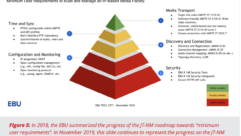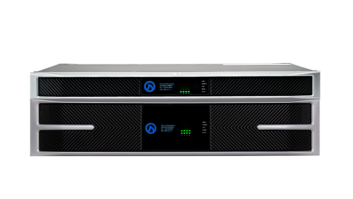
Network Misconceptions
Jul 11, 2014 3:22 PM, By Kevin Gross
Working with IT on AV networking projects

There is increasing overlap between information technology (IT) and audiovisual (AV) roles in projects and events. It is essential for AV professionals to work effectively with IT professionals. Establishing a good working relationship means understanding the IT point of view and being able to speak IT language and, where possible, to use technology that is most compatible with systems already in use in IT. Understanding the IT point of view requires addressing common misconceptions the AV community may hold toward IT and vice versa.
AV MISCONCEPTIONS OF IT
The cloud is magic and amazing.
In network design, it is common to represent an entire network as a cloud. In this conceptual representation, the cloud magically interconnects devices at whatever capacity is required. It is probably not a surprise that there’s a lot that goes on in that misty representation of the network, but this conceptual representation allows for inappropriate assumptions to be made from all sides about requirements. AV integrators need to be proactive in communicating requirements of their media devices and the connections between them to those responsible for designing and configuring the innards of these clouds. Without proactive communication, IT designers will assume AV as no special requirements.
Just because there’s an Ethernet connector on a piece of media gear doesn’t mean the network will readily support it. AV equipment may need specific network services that are not part of standard network configuration and design. Media networks typically need QoS to achieve low network latency and accurate synchronization. Some media systems need IEEE 1588 support in the network to assist with synchronization. Others make extensive use of multicast messaging and require IGMP or PIM support in the network. Deploying AVB requires special considerations from the beginning, as AVB-capable equipment is required along any network path through which media will travel.
IT won’t give me what I need
You may assume that purpose of an IT organization is to support network users and system designers such as yourself in making effective use of the network. For demanding network applications, such as media networking, it is healthier to think of IT as a collaborator. You will need to work with IT, not just issue the department requirements and wait for them to be fulfilled.
Your collaboration with IT on projects will be most successful if, whether they request it or not, you can give your IT pros an overview of how the AV system works and what it needs to accomplish. Give flexible requirements where possible. Discuss requirements early in the design cycle and find reasons to communicate with network engineers regularly to resolve any open questions and keep things moving forward. Recognize that yours are not the only requirements that need to be met. Appreciate that many IT pros have limited experience with AV and that they may be unsure how to assess or apply stated requirements. Recognize that there are other potentially conflicting requirements—such as network management, maintainability, and security—that may be unimportant or less important to you but that also need to be met.
In some cases, IT absolutely won’t give you what you want. If you have communicated early, and this is caught before too much time is spent on an unworkable design, things can be changed in favor of something more compatible with what IT is able to provide. As in AV, technology in the IT field changes rapidly, and recently evolved IT best practices may be out of step with some current and past media networking technologies. Newer protocols such as Dante, Q-LAN, and AES67 have been designed to be compatible with modern IT best practices.
Network Misconceptions
Jul 11, 2014 3:22 PM, By Kevin Gross
Working with IT on AV networking projects
IT MISCONCEPTIONS OF AV
VoIP is the most demanding network application
Through the use of voice over IP (VoIP), today most phone systems are connected to a computer network instead of using dedicated wiring and equipment. The network used for the telephone system is often the same one used for computers and other IT. Telephone calls over the network require higher performance than is demanded by other IT applications such as email delivery and web browsing. This performance requirement has been simplified in some corners of the IT industry to an understanding that VoIP requires the highest level of network performance available. This simplification leaves no room for applications that require higher performance than VoIP.
The good news is that while network performance has improved over the two decades since VoIP was first introduced, the performance requirements for VoIP have not changed significantly. The improved performance provided by networks is now available to applications requiring higher performance than VoIP. The highest tier of network performance should no longer be reserved for VoIP. Higher performance needs to be allocated to higher performance applications including media networking.
AV has no special requirements
A typical network configuration starts with all services and devices given equal access to network resources. Network engineers may not fully appreciate that media networking is a network application and deserves, if not requires, special configuration considerations.
IT pros have received little or no training and are generally unfamiliar with professional media networking. The network applications IT professionals are familiar with originate from PCs and servers, and include email delivery, web browsing, file transfers, and remote system and database access. Most of these applications are not particularly time sensitive. They also consume bandwidth on a sporadic basis—when an email comes in, when a web page is requested, when a file transfer is initiated. Most of these applications use TCP and are resilient to variable network performance.
Acceptable audio latency for some media networking applications is less than 1 millisecond—100 times lower than are required for VoIP. Packet loss is sometimes tolerable in VoIP and does not severely impact other IT services. Packets delayed in transit through the network may arrive too late to be useable at the media network receiver. Any dropped data will result in audible artifacts and in some media networking applications; no packet loss is acceptable.
In short, the assumptions that network designers are accustomed to making about network applications do not serve media networking. Network designers need to be made aware of these special requirements early in the design process.
This AV traffic is going to trash my network
Professional networked audio can continuously use 1Mb to 2Mb per channel, up to 100 times the bandwidth used by VoIP calls which typically aren’t run continuously. A multichannel audio device such as a mixing console can saturate a Gigabit Ethernet link. The bandwidth consumed by media networking may dwarf that used by all other applications on some networks. Some networks are only capable of supporting the more modest and elastic requirements of computer network applications.
IPTV and some other media networking systems use multicast messaging. Because multicast is often used only lightly, many networks lack intelligence for handling multicast traffic and will disruptively distribute multicast to all devices on the network or within the immediate vicinity of the multicast source.
Some media networking systems use Layer 2 Ethernet traffic. Much of the IT infrastructure and tools are geared towards Layer 3 IP traffic. The Ethernet traffic produced by these systems may be less visible, more difficult to control and manage, and dealing with it may be considered anywhere from an inconvenience to an unacceptable security risk.
So maybe AV traffic trashing a network isn’t a misconception in some cases. Media networking definitely pushes networks to a degree that may be surprising to IT pros not accustom to supporting high-performance networking. Fortunately, there are well-established IT techniques, standards, and technologies for addressing these issues. The distance between media network requirements and affordable network capabilities has been closing quickly. The gap between capabilities and requirements is less of an issue for newer network installations or moderate-sized media networks.
All necessary information is available in the documentation
Documentation for IT systems is typically extensive. The manual for a typical enterprise-grade network switch can run more than 1,000 pages. Technical features are defined in similarly extensive standards published by the IEEE, IETF, and others. There is a rich array of information and training for IT pros to draw upon when working with network systems.
Media network technology has only recently begun to conform to published standards. Protocol details may not be published in AV product documentation. These systems are supported by AV companies who may not speak the same language as the IT pros.
Despite their girth, product documentation for networking equipment may not contain the information needed to determine whether and how to make these systems support one another. Few switches, for instance, give a usable latency specification. Most network equipment supports QoS capabilities, but the exact nature of these capabilities and their compatibility with media networking systems can be impossible to ascertain without testing. In short, due to a lack of information, incompatibility, or difficulty interpreting specifications, it may be very difficult to determine whether media networking system B is compatible with network A.
Network Misconceptions
Jul 11, 2014 3:22 PM, By Kevin Gross
Working with IT on AV networking projects
AES67
A new generation of media network systems is now available. Whereas previous generations used standard network equipment to varying degrees but were otherwise purpose-built for audio networking, the latest generation makes better use of existing open standards to solve the problem. This new generation therefore represents a more IT-friendly approach to media networking. Although this means that these new system tend to operate on the same or similar principles and can coexist on the same network, they are each different enough so as not to interoperate with one another.
The AES67 standard is an attempt to allow this new generation of media networks to interoperate. AES67 is not a new technology. It takes the core ideas from these new systems and is a close cousin to the systems it connects. AES67 may be implemented as an interoperability mode or feature in existing products and systems. It is also comprehensive and capable enough to be used alone.
The project was initiated in late 2010, and the standards were developed between June 2011 and September 2013 with more than 100 materially affected individuals from prominent audio, video, and IT companies participating. Three principles guided the work:
- 1. Focus on basic interoperability
2. Use Layer 3 protocols
3. Leverage existing standards and IT practices wherever possible.
The result is a standard for professional media networking interoperability,y which is essentially a jacked up VoIP system that provides the quality, low audio latency, capacity, and accuracy required by professional applications. Specifically, AES67 uses:
- IEEE 1588 for synchronization
- RTP over IP for media clocking and transport
- SDP to describe connections
- SIP to negotiate and make connections
- IGMP for multicast management
- DiffServ for QoS
With AES67 implemented in networked audio products, AV pros will have more options for connections; IT pros will have fewer and less quirky systems to learn about and can leverage their existing knowledge of VoIP and IP for successful media networking deployments.
Kevin Gross is an independent network designer and media networking consultant. He conceived and developed Cobranet 20 years ago. As a member of the IEEE 802.1 and 1722 standards committees, he helped develop AVB. In 2006 he was awarded an AES fellowship for his contributions to digital audio networking. Gross recently led the development of the AES67 audio networking interoperability standard. He can be reached by visiting avanw.com.










